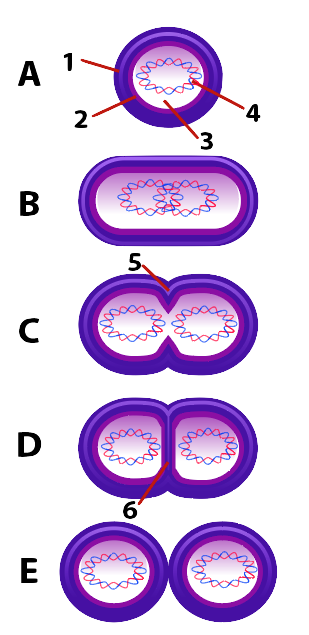Looking for a student learning guide? It’s linked in the main menu for your course. Use the “Courses” menu above.
1. Shouldn’t all the bacteria of the same species be clones?
Meet E. coli.
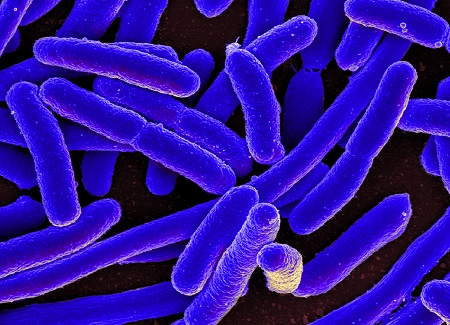
E. coli is a bacterium that lives in the colons of humans and all endothermic (“warm-blooded”) vertebrates (specifically: mammals and birds). They’re about 2 micrometers long, and from 0.25 to one micrometer across (Wikipedia). E. coli are a normal and healthy part of what’s called our intestinal flora: you have about as many E. coli cells inside of you at any one moment as you have cells that are you (though that number of E. coli cells, 30 trillion, drops every time you have a bowel movement). Nat. Geo.
All bacteria, including E. coli, reproduce asexually through a process called binary fission, which you can follow through the diagram on the right.
In “A,” you see a single bacterial cell with a cell wall (“1”), a membrane (“2”), cytoplasm (“3”), and a single circular chromosome (“4”). Bacteria also have additional pieces of DNA called “plasmids,” which are not shown at right (but which you’ll meet below).
When bacteria divide, they start by elongating, and by replicating their DNA, as shown in “B.”
In “C,” you can see that the cell now has two chromosomes and that a new cell wall is beginning to form (at “5”).
By step “D” the cell wall (now “6”) has divided the parent cell into two daughter cells, which split apart into the two daughter cells (shown at “E”).
This process clones the parent into two identical daughter cells. Yet, bacterial populations are genetically diverse. For example, E. coli consists of several strains. Most of these are harmless, but some can cause bacterial irritation and diarrhea, which can lead to dehydration that can be fatal (especially in toddlers or people with compromised immunity).
Where does this bacterial diversity come from? If bacteria multiply through cloning, why aren’t they all the same? Before reading further, think about what you know about biology, and see if you can come up with an answer.
2. Five Causes of Bacterial Genetic Diversity
Bacteria genetically differ from one another for five reasons.
2a. Mutation
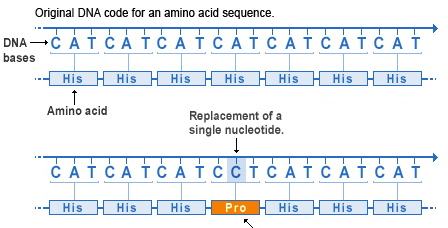
Bacterial genes are made of DNA. Despite DNA’s stability, mutations in DNA’s base sequence occasionally occur. And because bacteria reproduce so quickly (E. coli can double itself in as little as 20 minutes), even the smallest mutation rate will lead to large numbers of mutants within any E. coli population.
Note that in the example to the left, a single substitution of cytosine for adenine results in the amino acid proline replacing histidine (which could alter the tertiary interactions that give rise to the protein’s three-dimensional conformation, potentially changing the protein’s function as well).
2b. Transformation
Bacterial transformation played a major role in the identification of DNA as the genetic material in the 1930s and 40s, leading to the elucidation of DNA’s structure by Watson, Crick, Franklin, and Wilkins.
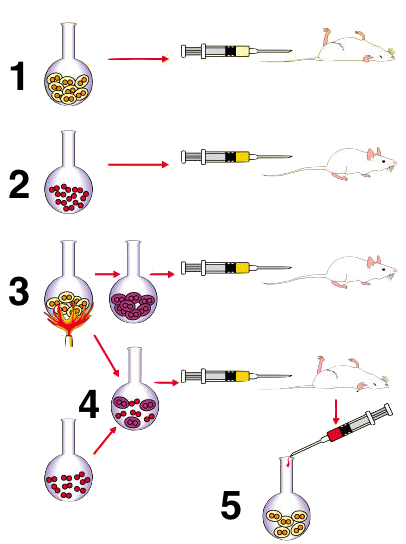 The image on the left shows the setup of an experiment by Frederick Griffith that demonstrated bacterial transformation.
The image on the left shows the setup of an experiment by Frederick Griffith that demonstrated bacterial transformation.
Flasks 1 and 2 contain different strains of Pneumococcus bacteria. In flask 1, the bacteria are smooth-strained. Each cell is surrounded by a capsule, and when injected into mice, these bacteria are lethal.
In flask 2, the bacteria are rough-strained. They lack a capsule and are harmless when injected into mice.
Flask 3 shows that when smooth-strain bacteria are killed by heating, they can be injected into mice without harm.
But when the heat-killed bacteria from flask 3 are mixed with the rough-strain bacteria (step 4), the injected mixture becomes lethal. When the blood of the dead mice is sampled for bacteria, the bacteria found are the smooth strain.
What’s happening?
[qwiz qrecord_id=”sciencemusicvideosMeister1961-Bacterial Transformation Quiz”]
[h]Bacterial transformation
[q] See if you can explain what must be happening in steps 3, 4, and 5.
[c]IFNob3cgbWUgdG hlIGFuc3dlcg==[Qq]
[f]IEFzIHNob3duIGluIGRpYWdyYW0gJiM4MjIwOzMsJiM4MjIxOyB3aGVuIHRoZSBkZWFkbHkgc21vb3RoIHN0cmFpbiBiYWN0ZXJpYSBhcmUgaGVhdGVkLCB0aGV5IGRpZSBhbmQgY2FuIGJlIGluamVjdGVkIHdpdGhvdXQgaGFybS4gSG93ZXZlciwgd2hlbiBoZWF0LWtpbGxlZCBzbW9vdGgtc3RyYWluIGJhY3RlcmlhIGFyZSBtaXhlZCB3aXRoIGxpdmluZywgcm91Z2gtc3RyYWluIGJhY3RlcmlhIChhcyBzaG93biBpbiAmIzgyMjA7NCYjODIyMTspIHRoZW4gc29tZXRoaW5nIGluIHRoZSBkZWFkIGhlYXQta2lsbGVkIGJhY3RlcmlhIGlzIGFibGUgdG8gdHJhbnNmb3JtIHRoZSBoYXJtbGVzcyByb3VnaC1zdHJhaW4gYmFjdGVyaWEgaW50byBkZWFkbHkgc21vb3RoLXN0cmFpbiBiYWN0ZXJpYQ==ICh3aGljaCBhcmUgc2hvd24gaW4gdGhlIG1pY2UmIzgyMTc7cyBibG9vZCBpbiBzdGVwICYjODIyMDs1LiYjODIyMTspLiBUaGF0ICYjODIyMDtzb21ldGhpbmcmIzgyMjE7IHR1cm5zIG91dCB0aGUgYmUgRE5BLCB3aGljaCBjYW4gZW50ZXIgY2VsbHMgKGFuZCBoYXZlIGl0cyB0cmFuc2Zvcm1pbmcgZWZmZWN0KSBpbiB0d28gd2F5cy4=[Qq]
[q] See if you can explain to yourself (or your partner, if you’re working with one) what’s happening in each diagram. Then click the button to confirm your answer.
[c]IFNob3cgbWUgdG hlIGFuc3dlcg==[Qq]
[f]SW4gYm90aCBkaWFncmFtcywgJiM4MjIwO2ImIzgyMjE7IHJlcHJlc2VudHMgdGhlIGJhY3RlcmlhbCBjaHJvbW9zb21lLg==
Cg==| [Qq]The diagram to the left shows the uptake of “naked” DNA. Cells absorb fragments of DNA (“a”) in their environment, and this DNA incorporates itself into the host cell chromosome (“c”). | The diagram to the right shows the uptake of plasmid DNA. Plasmids (“a”) are small circles of DNA that are not a part of the main bacterial chromosome. Bacteria can exchange plasmids through a process called conjugation (discussed below) or plasmids can enter a bacterial cell. Once inside the cell, the plasmid DNA can be replicated and/or expressed. |
[/qwiz]
2c. Bacterial Conjugation
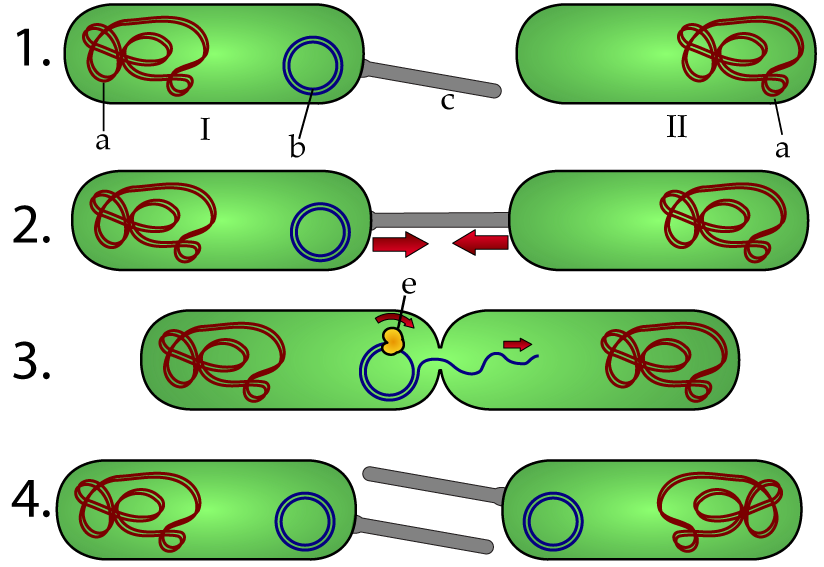
Like one of the forms of transformation that we saw above, bacterial conjugation involves an exchange of plasmids. However, while bacterial transformation involves the accidental acquisition of foreign genetic material, conjugation is much more directed. Here’s how it works.
In step “1” we see two bacteria of the same species. Bacteria “I” has a plasmid, and this plasmid has genes for the production of a structure called a pilus (at “c”). The second bacterium, at II, lacks both the plasmid (and the pilus).
Functionally, the pilus is like a retractable hook. When the pilus contacts the surface of another bacterium (as it does in step “2”), it grabs on. As it grabs on, the pilus retracts, pulling the two cells together.
In step 3, the enzyme DNA polymerase (at “e”) replicates the plasmid, Other enzymes (not shown) create a cytoplasmic bridge between the two cells. Through this bridge, a copy of the plasmid enters cell II.
In step 4, you can see the result. Because cell II now has the plasmid, it expresses genes for the pilus.
Note that the plasmids behind the conjugation process can have a variety of genes. It’s thought that conjugation, in addition to mutation, is a key mechanism by which antibiotic resistance genes spread through bacterial populations.
2d. Transduction
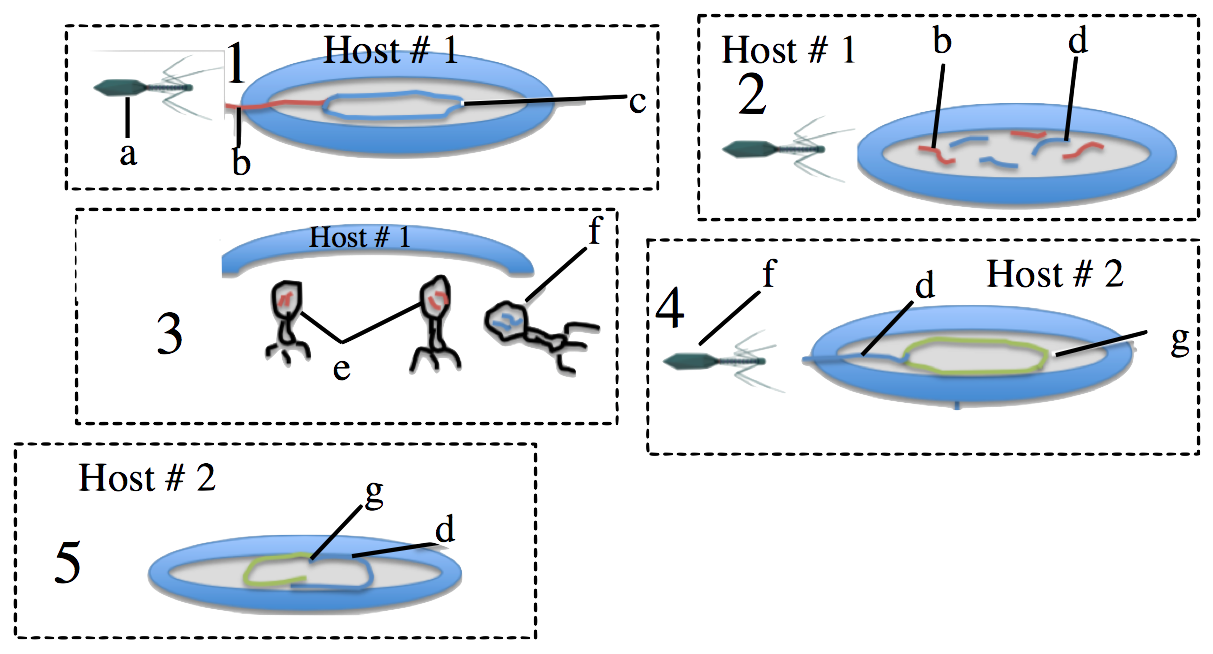
Transduction is a process in which accidents in viral replication result in moving DNA fragments from one bacterium to another. Depending on your instructor’s sequence, you might have already covered this….or you’ll learn about this in more detail in our tutorial about viruses. If you need to learn about this now, click here, then come on back to this module.
2e. Transposition
Transposons, or transposable genetic elements, are DNA sequences that can move from one location in an organism’s genome to another. They were discovered by the Nobel-Prize-winning geneticist Barbara McClintock (who had to wait about 40 years before her work was widely recognized and deemed Nobel Prize worthy).
Transposons occur in all living things. Astonishingly, 44% of the human genome is composed of DNA that originated from transposons. Wikipedia. That’s also true of other mammalian genomes.
There are two ways that transposons work.
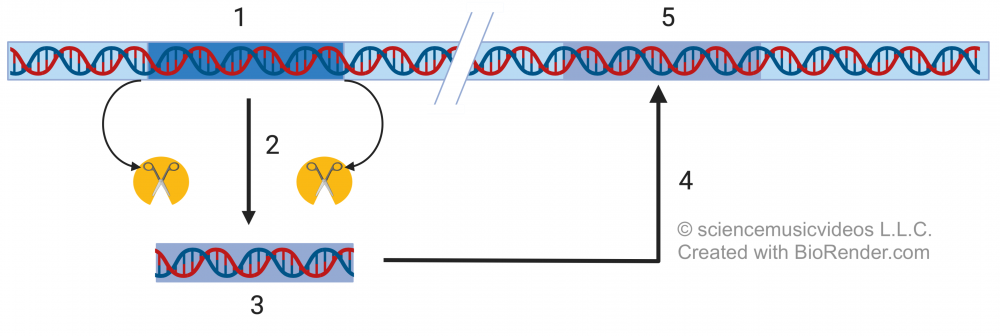
The first is analogous to what happens when you cut and paste text in a word processor. The transposon (1) codes for enzymes called transposases, represented by the Pacman scissors. The transposases cut the transposon sequence out of its current location within a chromosome (2 and 3) and then insert the transposon back in somewhere else (4 and 5). This changes the sequence of genes on a chromosome, but it doesn’t increase the size of the genome: the number of nucleotides stays the same.
But transposons can also replicate themselves through a copy and paste mechanism. When you’re typing, and you copy and paste, you increase the number of characters in the document that you’re creating. The transposons that work through copy and paste are retrotransposons, and they work as follows.
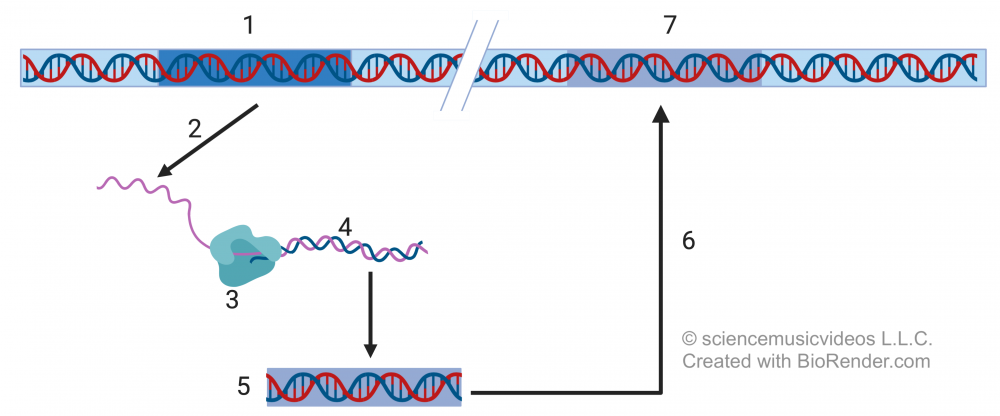
In the image above, “1” shows a retrotransposon. In step 2, this transposon’s DNA is transcribed into RNA, which is shown in red. Next, reverse transcriptase (“3”) creates DNA from the RNA (steps “4” and “5.”)
Notice that the DNA of the original retrotransposon is still in its original location, which means that the DNA at “5” is a clone of “1.” In step 6, the new DNA is inserted somewhere else in the genome (“7”). The transposon, in this case, has both changed this organism’s genetic sequence and increased its genome size.
3. Checking Understanding
That explains what you need to know about how genetic diversity is generated in bacteria. Take the quiz below to see how well you’ve mastered what you’ve read.
[qwiz qrecord_id=”sciencemusicvideosMeister1961-Bacterial Genetic Diversity (5 causes)” random = “true” style=”width: 650px !important; min-height: 400px !important;”]
[h] Genetic Diversity in Bacteria
[i]
[q] The process shown below represents [hangman]
[c]IHRyYW5zZm9ybWF0aW9u[Qq]
[f]IEdvb2Qh[Qq]
[q] The process shown below represents transformation with [hangman] DNA.
[c]IG5ha2Vk[Qq]
[f]IEdvb2Qh[Qq]
[q] The process shown below represents transformation with a [hangman].
[c]IHBsYXNtaWQ=[Qq]
[f]IEdvb2Qh[Qq]
[q] The process shown below represents [hangman].
[c]IGNvbmp1Z2F0aW9u[Qq]
[f]IEV4Y2VsbGVudCE=[Qq]
[q] The structure shown at “c” is a [hangman].
[c]IHBpbHVz[Qq]
[f]IE5pY2UgSm9iIQ==[Qq]
[q] The enzyme shown at “e” is DNA [hangman].
[c]IHBvbHltZXJhc2U=[Qq]
[f]IE5pY2UgSm9iIQ==[Qq]
[q] The process shown below is [hangman].
[c]IHRyYW5zcG9zaXRpb24=[Qq]
[f]IEF3ZXNvbWUh[Qq]
[q] The DNA elements shown at 1, 3, and 5 are [hangman].
[c]IHRyYW5zcG9zb25z[Qq]
[f]IEF3ZXNvbWUh[Qq]
[q] The DNA elements shown at 1, 5, and 7 are [hangman].
[c]IHJldHJvdHJhbnNwb3NvbnM=[Qq]
[f]IEdvb2Qh[Qq]
[q] The enzyme shown at 3 is reverse [hangman].
[c]IHRyYW5zY3JpcHRhc2U=[Qq]
[f]IEF3ZXNvbWUh[Qq]
[q] The process shown below is [hangman].
[c]IHRyYW5zZHVjdGlvbg==[Qq]
[f]IEV4Y2VsbGVudCE=[Qq]
[q] The result of the process below is two daughter cells that are genetic [hangman] of the parent cell.
[c]IGNsb25lcw==[Qq]
[f]IEF3ZXNvbWUh[Qq]
[q] The process below is called [hangman].
[c]IG11dGF0aW9u[Qq]
[f]IEF3ZXNvbWUh[Qq]
[q] Mutation, transduction, transformation, conjugation, and transposition are all processes that increase genetic [hangman] in bacterial populations.
[c]IGRpdmVyc2l0eQ==[Qq]
[f]IEF3ZXNvbWUh[Qq]
[q multiple_choice=”true”] The process below shows
[c]IG11dGF0aW9u[Qq]
[f]IE5vLiBNdXRhdGlvbiBpbnZvbHZlcyBhIHJhbmRvbSBjaGFuZ2UgaW4gbnVjbGVvdGlkZSBzZXF1ZW5jZQ==[Qq]
[c]IHRyYW5zcG9zaXRpb24=[Qq]
[f]IE5vLiBUcmFuc3Bvc2l0aW9uIGludm9sdmVzIHRyYW5zcG9zb25zIG1vdmluZyBmcm9tIG9uZSBsb2NhdGlvbiBpbiB0aGUgZ2Vub21lIHRvIGFub3RoZXIgbG9jYXRpb24u[Qq]
[c]IHRyYW5zZm 9ybWF0aW9u[Qq]
[f]IEV4Y2VsbGVudC4gVGhpcyBkaWFncmFtIHNob3dzIGhvdyBETkEgZnJvbSBoZWF0LWtpbGxlZCB2aXJ1bGVudCBiYWN0ZXJpYSB3YXMgYWJsZSB0byB0cmFuc2Zvcm0gaGFybWxlc3MgYmFjdGVyaWEgaW50byBkZWFkbHkgYmFjdGVyaWEu[Qq]
[c]IGNvbmp1Z2F0aW9u[Qq]
[f]IE5vLiBDb25qdWdhdGlvbiBpbnZvbHZlcyB0aGUgdHJhbnNmZXIgb2YgYSBwbGFzbWlkIGJ5IG1lYW5zIG9mIGEgcGlsdXMu[Qq]
[c]IHRyYW5zZHVjdGlvbg==[Qq]
[f]IE5vLiBUcmFuc2R1Y3Rpb24gaW52b2x2ZXMgdGhlIHRyYW5zZmVyIG9mIGJhY3RlcmlhbCBETkHCoCB0aGF0IGNvbWVzIGFib3V0IHRocm91Z2ggYWNjaWRlbnRzIGluIHRoZSB2aXJhbCByZXBsaWNhdGlvbiBwcm9jZXNzLg==[Qq]
[q multiple_choice=”true”] The process below shows
[c]IG11dG F0aW9u[Qq]
[f]IFllcy4gTXV0YXRpb24gaW52b2x2ZXMgYSByYW5kb20gY2hhbmdlIGluIHRoZSBudWNsZW90aWRlIHNlcXVlbmNlLCB3aGljaCBpcyBleGFjdGx5IHdoYXQgeW91IHNlZSBoZXJlLg==[Qq]
[c]IHRyYW5zcG9zaXRpb24=[Qq]
[f]IE5vLiBUcmFuc3Bvc2l0aW9uIGludm9sdmVzIHRyYW5zcG9zb25zIG1vdmluZyBmcm9tIG9uZSBsb2NhdGlvbiBpbiB0aGUgZ2Vub21lIHRvIGFub3RoZXIgbG9jYXRpb24u[Qq]
[c]IHRyYW5zZm9ybWF0aW9u[Qq]
[f]IE5vLiBUaGlzIGRpYWdyYW0gc2hvd3MgaG93IEROQSBmcm9tIGhlYXQta2lsbGVkIHZpcnVsZW50IGJhY3RlcmlhIHdhcyBhYmxlIHRvIHRyYW5zZm9ybSBoYXJtbGVzcyBiYWN0ZXJpYSBpbnRvIGRlYWRseSBiYWN0ZXJpYS4=[Qq]
[c]IGNvbmp1Z2F0aW9u[Qq]
[f]IE5vLiBDb25qdWdhdGlvbiBpbnZvbHZlcyB0aGUgdHJhbnNmZXIgb2YgYSBwbGFzbWlkIGJ5IG1lYW5zIG9mIGEgcGlsdXMu[Qq]
[c]IHRyYW5zZHVjdGlvbg==[Qq]
[f]IE5vLiBUcmFuc2R1Y3Rpb24gaW52b2x2ZXMgdGhlIHRyYW5zZmVyIG9mIGJhY3RlcmlhbCBETkHCoCB0aGF0IGNvbWVzIGFib3V0IHRocm91Z2ggYWNjaWRlbnRzIGluIHRoZSB2aXJhbCByZXBsaWNhdGlvbiBwcm9jZXNzLg==[Qq]
[q multiple_choice=”true”] The process below shows
[c]IG11dGF0aW9u[Qq]
[f]IE5vLiBNdXRhdGlvbiBpbnZvbHZlcyBhIHJhbmRvbSBjaGFuZ2UgaW4gdGhlIG51Y2xlb3RpZGUgc2VxdWVuY2Us[Qq]
[c]IHRyYW5zcG 9zaXRpb24=[Qq]
[f]IFllcy4gVHJhbnNwb3NpdGlvbiBpbnZvbHZlcyB0cmFuc3Bvc29ucyBtb3ZpbmcgZnJvbSBvbmUgbG9jYXRpb24gaW4gdGhlIGdlbm9tZSB0byBhbm90aGVyIGxvY2F0aW9uLg==[Qq]
[c]IHRyYW5zZm9ybWF0aW9u[Qq]
[f]IE5vLiBUaGlzIGRpYWdyYW0gc2hvd3MgaG93IEROQSBmcm9tIGhlYXQta2lsbGVkIHZpcnVsZW50IGJhY3RlcmlhIHdhcyBhYmxlIHRvIHRyYW5zZm9ybSBoYXJtbGVzcyBiYWN0ZXJpYSBpbnRvIGRlYWRseSBiYWN0ZXJpYS4=[Qq]
[c]IGNvbmp1Z2F0aW9u[Qq]
[f]IE5vLiBDb25qdWdhdGlvbiBpbnZvbHZlcyB0aGUgdHJhbnNmZXIgb2YgYSBwbGFzbWlkIGJ5IG1lYW5zIG9mIGEgcGlsdXMu[Qq]
[c]IHRyYW5zZHVjdGlvbg==[Qq]
[f]IE5vLiBUcmFuc2R1Y3Rpb24gaW52b2x2ZXMgdGhlIHRyYW5zZmVyIG9mIGJhY3RlcmlhbCBETkHCoCB0aGF0IGNvbWVzIGFib3V0IHRocm91Z2ggYWNjaWRlbnRzIGluIHRoZSB2aXJhbCByZXBsaWNhdGlvbiBwcm9jZXNzLg==[Qq]
[q multiple_choice=”true”] The process below shows
[c]IG11dGF0aW9u[Qq]
[f]IE5vLiBNdXRhdGlvbiBpbnZvbHZlcyBhIHJhbmRvbSBjaGFuZ2UgaW4gdGhlIG51Y2xlb3RpZGUgc2VxdWVuY2Us[Qq]
[c]IHRyYW5zcG9zaXRpb24=[Qq]
[f]IE5vLiBUcmFuc3Bvc2l0aW9uIGludm9sdmVzIHRyYW5zcG9zb25zIG1vdmluZyBmcm9tIG9uZSBsb2NhdGlvbiBpbiB0aGUgZ2Vub21lIHRvIGFub3RoZXIgbG9jYXRpb24u[Qq]
[c]IHRyYW5zZm9ybWF0aW9u[Qq]
[f]IE5vLiBUaGlzIGRpYWdyYW0gc2hvd3MgaG93IEROQSBmcm9tIGhlYXQta2lsbGVkIHZpcnVsZW50IGJhY3RlcmlhIHdhcyBhYmxlIHRvIHRyYW5zZm9ybSBoYXJtbGVzcyBiYWN0ZXJpYSBpbnRvIGRlYWRseSBiYWN0ZXJpYS4=[Qq]
[c]IGNvbmp1 Z2F0aW9u[Qq]
[f]IFllcy4gQ29uanVnYXRpb24gaW52b2x2ZXMgdGhlIHRyYW5zZmVyIG9mIGEgcGxhc21pZCBieSBtZWFucyBvZiBhIHBpbHVzLg==[Qq]
[c]IHRyYW5zZHVjdGlvbg==[Qq]
[f]IE5vLiBUcmFuc2R1Y3Rpb24gaW52b2x2ZXMgdGhlIHRyYW5zZmVyIG9mIGJhY3RlcmlhbCBETkHCoCB0aGF0IGNvbWVzIGFib3V0IHRocm91Z2ggYWNjaWRlbnRzIGluIHRoZSB2aXJhbCByZXBsaWNhdGlvbiBwcm9jZXNzLg==[Qq]
[q multiple_choice=”true”] The process below shows
[c]IG11dGF0aW9u[Qq]
[f]IE5vLiBNdXRhdGlvbiBpbnZvbHZlcyBhIHJhbmRvbSBjaGFuZ2UgaW4gdGhlIG51Y2xlb3RpZGUgc2VxdWVuY2Us[Qq]
[c]IHRyYW5zcG9zaXRpb24=[Qq]
[f]IE5vLiBUcmFuc3Bvc2l0aW9uIGludm9sdmVzIHRyYW5zcG9zb25zIG1vdmluZyBmcm9tIG9uZSBsb2NhdGlvbiBpbiB0aGUgZ2Vub21lIHRvIGFub3RoZXIgbG9jYXRpb24u[Qq]
[c]IHRyYW5zZm9ybWF0aW9u[Qq]
[f]IE5vLiBUaGlzIGRpYWdyYW0gc2hvd3MgaG93IEROQSBmcm9tIGhlYXQta2lsbGVkIHZpcnVsZW50IGJhY3RlcmlhIHdhcyBhYmxlIHRvIHRyYW5zZm9ybSBoYXJtbGVzcyBiYWN0ZXJpYSBpbnRvIGRlYWRseSBiYWN0ZXJpYS4=[Qq]
[c]IGNvbmp1Z2F0aW9u[Qq]
[f]IFllcy4gQ29uanVnYXRpb24gaW52b2x2ZXMgdGhlIHRyYW5zZmVyIG9mIGEgcGxhc21pZCBieSBtZWFucyBvZiBhIHBpbHVzLg==[Qq]
[c]IHRyYW5zZH VjdGlvbg==[Qq]
[f]IFllcy4gVHJhbnNkdWN0aW9uIGludm9sdmVzIHRoZSB0cmFuc2ZlciBvZiBiYWN0ZXJpYWwgRE5BwqAgdGhhdCBjb21lcyBhYm91dCB0aHJvdWdoIGFjY2lkZW50cyBpbiB0aGUgdmlyYWwgcmVwbGljYXRpb24gcHJvY2Vzcy4=[Qq]
[q] In the diagram below, which letter or number indicates fragments of DNA that are floating in the environment?
[textentry single_char=”true”]
[c]IG E=[Qq]
[f]IEV4Y2VsbGVudCEgVGhlIGxldHRlciAmIzgyMjA7YSYjODIyMTsgcmVwcmVzZW50cyBETkEgZnJhZ21lbnRzIHRoYXQgYXJlIGZsb2F0aW5nIGluIHRoZSBlbnZpcm9ubWVudC4=[Qq]
[c]IEVudGVyIHdvcmQ=[Qq]
[f]IFNvcnJ5LCB0aGF0JiM4MjE3O3Mgbm90IGNvcnJlY3Qu[Qq]
[c]ICo=[Qq]
[f]IE5vLCBKdXN0IGxvb2sgZm9yIHNvbWV0aGluZ8Kgb3V0c2lkZQ==IG9mIHRoZSBjZWxsLg==[Qq]
[q] In the diagram below, which letter or number indicates the pre-transformation bacterial chromosome?
[textentry single_char=”true”]
[c]IG I=[Qq]
[f]IEV4Y2VsbGVudCEgTGV0dGVyICYjODIyMDtiJiM4MjIxOyByZXByZXNlbnRzIHRoZSBiYWN0ZXJpYWwgY2hyb21vc29tZSBiZWZvcmUgdHJhbnNmb3JtYXRpb24u[Qq]
[c]IEVudGVyIHdvcmQ=[Qq]
[f]IFNvcnJ5LCB0aGF0JiM4MjE3O3Mgbm90IGNvcnJlY3Qu[Qq]
[c]ICo=[Qq]
[f]IE5vLCBidXQgaGVyZSYjODIxNztzIGEgaGludDogQmFjdGVyaWEgaGF2ZSBhIHNpbmdsZSBjaXJjdWxhciBjaHJvbW9zb21lLg==[Qq]
[q] In the diagram below, which letter indicates a transformed chromosome (one that has taken up foreign DNA)?
[textentry single_char=”true”]
[c]IGM7 Mw==[Qq]
[f]IEV4Y2VsbGVudCEgTGV0dGVyICYjODIyMDtjJiM4MjIxOyByZXByZXNlbnRzIGEgYmFjdGVyaWFsIGNocm9tb3NvbWUgdGhhdCBoYXMgdGFrZW4gdXAgZm9yZWlnbiBETkEsIGFuZCBoYXMgYmVlbiB0cmFuc2Zvcm1lZC4=[Qq]
[c]IEVudGVyIHdvcmQ=[Qq]
[f]IE5vLg==[Qq]
[c]ICo=[Qq]
[f]IE5vLCBidXQgaGVyZSYjODIxNztzIGEgaGludDogZmluZCBhIGNocm9tb3NvbWUgdGhhdCBjb25zaXN0cyBvZiBib3RoIHRoZSBvcmlnaW5hbCBETkEgYW5kIHRoZSBmb3JlaWduIEROQSB0aGF0IGVudGVyZWQgdGhlIGNlbGwu[Qq]
[q] In the diagram below, which letter or number indicates a plasmid?
[textentry single_char=”true”]
[c]IG E=[Qq]
[f]IE5pY2UhIFRoZSBsZXR0ZXIgJiM4MjIwO2EmIzgyMjE7IHJlcHJlc2VudHMgYSBwbGFzbWlkLg==[Qq]
[c]IEVudGVyIHdvcmQ=[Qq]
[f]IFNvcnJ5LCB0aGF0JiM4MjE3O3Mgbm90IGNvcnJlY3Qu[Qq]
[c]ICo=[Qq]
[f]IE5vLCBidXQgaGVyZSYjODIxNztzIGEgaGludDogQSBwbGFzbWlkIGlzIGEgY2lyY2xlIG9mIGV4dHJhLWNocm9tb3NvbWFsIEROQSBmb3VuZCBvdXRzaWRlIHRoZSBtYWluIGJhY3RlcmlhbCBjaHJvbW9zb21lLg==[Qq]
[q] In the diagram below, which letter or number indicates a plasmid?
[textentry single_char=”true”]
[c]IG I=[Qq]
[f]IE5pY2UhIExldHRlciAmIzgyMjA7YiYjODIyMTsgcmVwcmVzZW50cyBhIHBsYXNtaWQu[Qq]
[c]IEVudGVyIHdvcmQ=[Qq]
[f]IFNvcnJ5LCB0aGF0JiM4MjE3O3Mgbm90IGNvcnJlY3Qu[Qq]
[c]ICo=[Qq]
[f]IE5vLCBidXQgaGVyZSYjODIxNztzIGEgaGludDogQSBwbGFzbWlkIGlzIGEgY2lyY2xlIG9mIGV4dHJhLWNocm9tb3NvbWFsIEROQSBmb3VuZCBvdXRzaWRlIHRoZSBtYWluIGJhY3RlcmlhbCBjaHJvbW9zb21lLg==[Qq]
[q] In the diagram below, which letter or number indicates the main bacterial chromosome?
[textentry single_char=”true”]
[c]IG E=[Qq]
[f]IE5pY2UhIFRoZSBsZXR0ZXIgJiM4MjIwO2EmIzgyMjE7IHJlcHJlc2VudHMgdGhlIG1haW4gYmFjdGVyaWFsIGNocm9tb3NvbWUu[Qq]
[c]IEVudGVyIHdvcmQ=[Qq]
[f]IFNvcnJ5LCB0aGF0JiM4MjE3O3Mgbm90IGNvcnJlY3Qu[Qq]
[c]ICo=[Qq]
[f]IE5vLCBUaGUgYmFjdGVyaWFsIGNocm9tb3NvbWUgaXMgYSBsb25nIGxvb3Agb2YgRE5BLCBtdWNoIGJpZ2dlciB0aGFuIHRoZSBwbGFzbWlkICh3aGljaCBpcyBzaG93biBhdCAmIzgyMjA7YiYjODIyMTsp[Qq]
[q] In the diagram below, which letter or number indicates a pilus?
[textentry single_char=”true”]
[c]IG M=[Qq]
[f]IE5pY2UhIExldHRlciAmIzgyMjA7YyYjODIyMTsgcmVwcmVzZW50cyBhIHBpbHVzLg==[Qq]
[c]IEVudGVyIHdvcmQ=[Qq]
[f]IFNvcnJ5LCB0aGF0JiM4MjE3O3Mgbm90IGNvcnJlY3Qu[Qq]
[c]ICo=[Qq]
[f]IE5vLCBUaGUgcGlsdXMgaXMgYW4gZXh0ZW5zaW9uIGZyb20gdGhlIGNlbGwgdGhhdCBncmFicyBvbnRvIG90aGVyIGNlbGxzLg==[Qq]
[q] In the diagram below, which letter or number indicates DNA polymerase?
[textentry single_char=”true”]
[c]IG U=[Qq]
[f]IE5pY2UhIExldHRlciAmIzgyMjA7ZSYjODIyMTsgcmVwcmVzZW50cyBETkEgcG9seW1lcmFzZS4=[Qq]
[c]IEVudGVyIHdvcmQ=[Qq]
[f]IFNvcnJ5LCB0aGF0JiM4MjE3O3Mgbm90IGNvcnJlY3Qu[Qq]
[c]ICo=[Qq]
[f]IE5vLCBUcnkgdG8gZmluZCBzb21ldGhpbmcgdGhhdCBjb3VsZCByZXByZXNlbnQgYW4gZW56eW1lIHRoYXQgaXMgcmVwbGljYXRpbmcgdGhlIHBsYXNtaWQu[Qq]
[q] In the diagram below, which number represents a transposon that has moved to a new position in the genome?
[textentry single_char=”true”]
[c]ID U=[Qq]
[f]IE5pY2UhIExldHRlciAmIzgyMjA7NSYjODIyMTsgcmVwcmVzZW50cyBhIHRyYW5zcG9zb24gdGhhdCBoYXMgbW92ZWQgdG8gYSBuZXcgcG9zaXRpb24gaW4gdGhlIGdlbm9tZS4=[Qq]
[c]IEVudGVyIHdvcmQ=[Qq]
[f]IFNvcnJ5LCB0aGF0JiM4MjE3O3Mgbm90IGNvcnJlY3Qu[Qq]
[c]ICo=[Qq]
[f]IE5vLiBJZiAmIzgyMjA7MSYjODIyMTsgaXMgdGhlIG9yaWdpbmFsIHRyYW5zcG9zb24sIHdoYXQmIzgyMTc7cyB0aGUgb25seSB0aGluZyB0aGF0IGNvdWxkIHJlcHJlc2VudCB0aGlzIHRyYW5zcG9zb24gaW4gYSBuZXcgcG9zaXRpb24gaW4gdGhlIGdlbm9tZT8=[Qq]
[q] In the diagram below, which number represents the process of transposon insertion?
[textentry single_char=”true”]
[c]ID Q=[Qq]
[f]IE5pY2UhIExldHRlciAmIzgyMjA7NCYjODIyMTsgcmVwcmVzZW50cyB0aGUgcHJvY2VzcyBvZiB0cmFuc3Bvc29uIGluc2VydGlvbi4=[Qq]
[c]IEVudGVyIHdvcmQ=[Qq]
[f]IFNvcnJ5LCB0aGF0JiM4MjE3O3Mgbm90IGNvcnJlY3Qu[Qq]
[c]ICo=[Qq]
[f]IE5vLiBJZiAmIzgyMjA7MyYjODIyMTsgaXMgdGhlIHRyYW5zcG9zb24gYXdheSBmcm9tIGl0cyBvcmlnaW5hbCBwb3NpdGlvbiwgYW5kICYjODIyMDs1JiM4MjIxOyByZXByZXNlbnRzIHRoZSB0cmFuc3Bvc29uIGluIGl0cyBuZXcgcG9zaXRpb24sIHdoYXQmIzgyMTc7cyB0aGUgb25seSB0aGluZyB0aGF0IGNvdWxkIHJlcHJlc2VudCB0aGUgcHJvY2VzcyBvZiBpbnNlcnRpb24/[Qq]
[q] In the diagram below, which number represents reverse transcriptase?
[textentry single_char=”true”]
[c]ID M=[Qq]
[f]IE5pY2UhIExldHRlciAmIzgyMjA7MyYjODIyMTsgcmVwcmVzZW50cyByZXZlcnNlIHRyYW5zY3JpcHRhc2Uu[Qq]
[c]IEVudGVyIHdvcmQ=[Qq]
[f]IFNvcnJ5LCB0aGF0JiM4MjE3O3Mgbm90IGNvcnJlY3Qu[Qq]
[c]ICo=[Qq]
[f]IE5vLiBBbiBSTkEgdHJhbnNjcmlwdCBvZiB0aGUgcmV0cm90cmFuc3Bvc29uIEROQSBpcyBzaG93biBpbiByZWQsIHJpZ2h0IGJlbG93IG51bWJlciAmIzgyMjA7Mi4mIzgyMjE7IFdoaWNoIG51bWJlciBvbiB0aGUgZGlhZ3JhbSByZXByZXNlbnRzIGFuIGVuenltZSB0aGF0IGlzIGNvbnZlcnRpbmcgdGhpcyB0cmFuc3Bvc29uIFJOQSBpbnRvIHRyYW5zcG9zb24gRE5BPw==[Qq]
[q] In the diagram below, which letter represents a phage that has picked up bacterial DNA, instead of viral DNA?
[textentry single_char=”true”]
[c]IG Y=[Qq]
[f]IE5pY2UhIExldHRlciAmIzgyMjA7ZiYjODIyMTsgcmVwcmVzZW50cyBhIHBoYWdlIHRoYXQgaGFzIHBpY2tlZCB1cCBETkEgZnJvbSB0aGUgYmFjdGVyaXVtIGl0IGp1c3QgYXR0YWNrZWQsIGluc3RlYWQgb2YgdmlyYWwgRE5BLg==[Qq]
[c]IEVudGVyIHdvcmQ=[Qq]
[f]IFNvcnJ5LCB0aGF0JiM4MjE3O3Mgbm90IGNvcnJlY3Qu[Qq]
[c]ICo=[Qq]
[f]IE5vLiBTdGFydCBieSBub3RpbmcgdGhlIGNvbG9ycyBvZiB0aGUgdmlyYWwgRE5BIGFuZCBiYWN0ZXJpYWwgRE5BIGluIGZpZ3VyZSAxLiBUaGVuIGNhcmVmdWxseSBleGFtaW5lIGZpZ3VyZXMgMiBhbmQgMywgYW5kIGlkZW50aWZ5IHRoZSB2aXJ1cyB0aGF0IGhhcyBwaWNrZWQgdXAgdGhlIHdyb25nIEROQS4=[Qq]
[/qwiz]
Links
- Continue to Operons (the next tutorial in this series)
- Return to the Bacterial Genetics /Operons Menu

